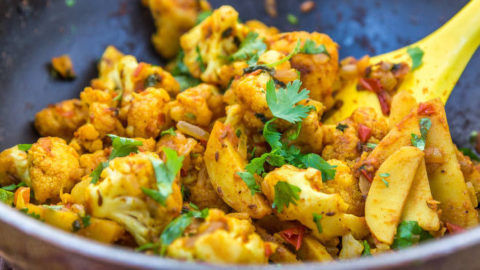Aloo Gobi, a classic Indian dish, showcases the humble yet versatile potato and cauliflower in a delightful medley of spices and flavors. Whether you’re a seasoned chef or a beginner in the kitchen, mastering the art of making Aloo Gobi can elevate your culinary repertoire. In this comprehensive guide, we’ll delve into the origins of Aloo Gobi, explore various recipes, discuss ingredient variations, and offer cooking tips to ensure your dish turns out perfect every time.
Origins and Significance of Aloo Gobi:
Aloo Gobi traces its roots to the Indian subcontinent, where potatoes and cauliflower are staple vegetables.
The dish holds cultural significance and is commonly prepared in households across India and neighboring countries.
Its popularity extends globally, with Aloo Gobi featuring on menus of Indian restaurants worldwide.
Basic Aloo Gobi Recipe:
Ingredients: Potatoes, cauliflower, onions, tomatoes, ginger, garlic, green chilies, turmeric, cumin seeds, coriander powder, garam masala, salt, and oil.
Cooking Method: Sauté onions, ginger, garlic, and green chilies until golden brown. Add spices and tomatoes, cook until oil separates. Add cauliflower and potatoes, cover, and cook until tender. Garnish with cilantro and serve hot.
Variations of Aloo Gobi:
Dry Aloo Gobi: Prepare without adding water, resulting in a semi-dry texture suitable as a side dish or filling for wraps.
Aloo Gobi Masala: Intensify flavors with additional spices like kasuri methi, cinnamon, and cloves.
Aloo Gobi Curry: Create a luscious gravy by blending onions, tomatoes, and cashews, then simmering the cooked vegetables in it.
Aloo Gobi with Paneer: Incorporate paneer cubes for added richness and protein.
Vegan Aloo Gobi: Substitute ghee with oil and skip paneer, ensuring all ingredients are plant-based.
Regional Aloo Gobi Varieties:
Punjabi Aloo Gobi: Features robust flavors with a generous amount of spices like kasuri methi and garam masala.
Bengali Aloo Gobi: Infuses a touch of sweetness with the addition of sugar or jaggery.
South Indian Aloo Gobi: Incorporates coconut milk or grated coconut for a creamy texture and subtle sweetness.
Pakistani Aloo Gobi: Typically includes fewer spices, allowing the natural flavors of the vegetables to shine.
Tips for Perfect Aloo Gobi:
Choose fresh, firm cauliflower and potatoes for the best texture and flavor.
Cut vegetables into uniform-sized pieces to ensure even cooking.
Toast whole spices like cumin seeds before adding to the dish for enhanced aroma.
Adjust spice levels according to personal preference, balancing heat with other flavors.
Experiment with additional ingredients like peas, bell peppers, or spinach for a unique twist.
Serving Suggestions:
Aloo Gobi pairs excellently with Indian breads like roti, naan, or paratha.
It can also be served alongside rice dishes such as pulao or biryani.
Accompany with a side of yogurt or cucumber raita to balance the spices.
Garnish with fresh cilantro, lime wedges, or sliced green chilies for added freshness and flavor.
Conclusion:
Aloo Gobi, with its simplicity and versatility, has earned its place as a beloved classic in Indian cuisine. Whether prepared traditionally or with innovative twists, this dish never fails to delight the taste buds. By exploring different recipes, variations, and cooking techniques, you can unlock the full potential of Aloo Gobi and impress your friends and family with your culinary prowess. So, roll up your sleeves, gather your ingredients, and embark on a flavorful journey with Aloo Gobi as your guide. Happy cooking!

